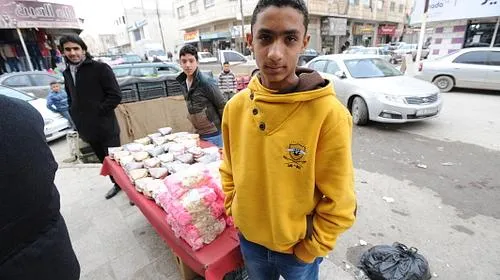AMMAN, Jordan (June 12, 2015) — On the occasion of the World Day Against Child Labor on June 12, the humanitarian agency CARE is highlighting concerns that Syrian refugee children, with few options and little choice, are being forced to enter the labor market, losing educational opportunities and facing increased protection risks.
At least four million Syrians have fled their homeland, seeking refuge in neighboring countries such as Jordan, Lebanon, Turkey, and Egypt. In Jordan, there are approximately 630,000 registered Syrian refugees living mostly in urban areas and camps. According to UNHCR, 52 percent of Syrian refugees in Jordan are under the age of 18.
In a recent assessment conducted by CARE Jordan, at least 10 percent of families interviewed said they use child labor as a coping strategy to cover their income-expenditure gap. Researchers say this figure is likely underreported due to issues of shame, honor, and the desire to appear favorably.
While most employed children are teenagers, reports show that some are as young as eight or nine years old.
“It’s not that families want their children working on the streets. This is not a choice, but a coping mechanism that signals desperation,” says Salam Kanaan, CARE Country Director in Jordan. “Families have too many expenses, no savings, and are falling deeper into debt with no way out.”
The CARE survey, which will be published later this month, found that 83 percent of families interviewed were carrying debt, with an increased average debt from last year. At least 23 percent of households are female-headed, with many husbands remaining in Syria, or in some cases, missing or killed. It is not uncommon in such cases that children find work to support their family.
Jordanian officials say the number of child laborers could be as high as 60,000. The ministry responsible for controlling child labor says half of child laborers picked up by authorities are Syrians. In Jordan, it is against the law to employ anyone under the age of 16.
In CARE’s assessment, most child laborers, including Syrians, were reported to be working as peddlers, in shops, restaurants, or on farms. Children can be seen working in car garages and construction sites.
“These working children are among the most vulnerable,” explains Kanaan. “They survived a war, only to suffer here with long work hours, and in sometimes dangerous and exploitative conditions, the impact of which could last a lifetime.”
Only 15 percent of Syrian refugee children working in Jordan had also worked in Syria, indicating that refugee displacement has increased the risk of child labor, even though many report that children in the workforce had already become common in Syria due to the war.
For some families, their priority now is to earn an income, not educate their children. At least half of the Syrian children who were reported as working said they had lost the opportunity to attend school, suggesting that labor is an important factor contributing to low school attendance rates.
Similar to CARE’s 2014 assessment, a higher percentage of boys (38 percent) than girls (33 percent) were out-of-school. Boys were more likely to be withdrawn from school than girls in order to engage in employment; 19 percent of adolescent boys (age 15-18) had dropped out of school to work, (while adolescent girls are more likely to leave school when they are engaged to marry).
“These children have already been stripped of their childhood by the war. But without education, they lose all opportunity for a better future,” says Kanaan. “We must help families find alternatives.”
Last year, CARE Jordan began offering support for families through a conditional cash assistance program that encourages parents to keep their children in school and out of the work force. By providing a cash subsidy, CARE helps families offset costs, substituting it for the income otherwise earned by a child, and at much greater personal cost.
“By helping children stay in school and out of the labor market, parents can better protect their children now and for the future,” Kanaan says. “In the long term though, we need to work towards increasing legal access to the labor market for people over the age of 16. If we don’t children, boys and girls, will remain at risk.”
Media contacts: Holly Frew, hfrew@care.org, 404.979.9389
About CARE
Founded in 1945, CARE is a leading humanitarian organization fighting global poverty and providing lifesaving assistance in emergencies. CARE places special focus on working alongside poor girls and women because, equipped with the proper resources, they have the power to help lift whole families and entire communities out of poverty. CARE has been working in Jordan since 1948. CARE Jordan has extensive experience working with refugees, providing livelihood training and opportunities, emergency cash assistance, information sharing and psychosocial support to Iraqi refugees since 2003.

